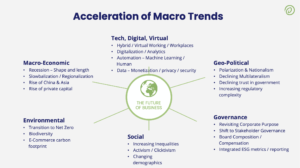Looking Ahead: Adapting to Changing Client Demands
 The legal industry has proved remarkably adept at adjusting to the Covid-19 pandemic and the economic shocks it continues to unleash. We’ve seen firms quickly turn themselves into virtual operations, continuing to deliver high quality services to clients both efficiently and profitably, with renewed commitment to health and wellbeing.
The legal industry has proved remarkably adept at adjusting to the Covid-19 pandemic and the economic shocks it continues to unleash. We’ve seen firms quickly turn themselves into virtual operations, continuing to deliver high quality services to clients both efficiently and profitably, with renewed commitment to health and wellbeing.
At the same time, the crisis has accelerated the macro trends that drive the business agenda of clients, highlighting growth opportunities and areas of risk that must be mitigated to ensure long-term success. This presents an important inflection point for law firm leaders – an opportunity to re-imagine how they create, deliver and price services in a way that meets clients’ rapidly evolving needs. To do so, they need to harness the spirit of adaptability they have shown during the crisis. But they also need the discipline to step back and review the fundamental changes happening in this new business environment.
That is tough to do at a time of such uncertainty, with pandemic restrictions still changing constantly, the precise trajectory of the economic recovery unknown, and with leaders being called to concurrently ensure the effective operational running of the business. It takes strong leadership to step out of the day-to-day fray and think strategically. But those that do will position their firms to thrive in this changed market.
We have drawn on our regular interviews with the clients of law firms and identified three themes that are fundamentally shaking up buyer demand and expectations:
- Macro trends driving boards to address new opportunities and risks
- A shift in the role of General Counsel to strategic business partner
- More choice and competition in the legal industry landscape
Macro trends driving boards to address new opportunities and risks
The pandemic crisis has had a deep and permanent impact on the overall business landscape, calling for fresh strategic thinking from companies across sectors. The diagram below captures the six macro trends that currently top boardroom agendas across sectors and markets:

Understanding how the world has changed for clients is vital because these changes, in turn, shape the new legal market. They will dictate where law firm leaders must look for new growth opportunities to sustain success long term.
Accelerating macro trends of particular note include: the shift from global to regional and national markets, the rise of private capital, increasing government and regulatory intervention, digitalization of business, and the rise of Environmental, Social, Governance (ESG) priorities.
Even firms that have operated successfully during the crisis need to consider these deeper-rooted issues boards are now grappling with, and ensure the firm aligns with client priorities.
The board-level strategic role for General Counsel
The power and influence of in-house counsel continues to grow. GCs are now positioned as strategic business partners, increasingly with a place at the boardroom table and a broader role to play beyond legal. A 2020 survey conducted by The Association of Corporate Counsel highlights that four out of five Chief Legal Officers now report directly to the CEO and have expanded responsibilities. These expanded responsibilities include brand protection, stakeholder relationships, and wider ESG issues core to the sustainability agenda.
Irrespective of whether there is an elevated board role, the overall shift is to a more strategic in-house legal role, which helps to identify the strategic opportunities that lie ahead for the business and mitigates the risks that might stand in the company’s way. It calls for the relationships and service offerings from external legal providers to be oriented around business issues. So, irrespective of whether a firm operates at a client’s board level, there exists an opportunity to help position the GC and in-house legal function in their expanded role.
The changing competitive landscape
Consolidation, choice and competition have transformed the competitive landscape in the legal sector and change will only increase.
Consolidation among established law firms looks set to continue at a global, regional, local and sector level, bringing new players into the frame. We expect mergers to rebound in 2021 and beyond, as firms execute on ambitious growth strategies to increase profile and market share.
Clients now have a much wider choice of service providers, particularly in the ‘New Law’ segment, with the Big 4 and New Law Companies making increased inroads into markets previously dominated by law firms. Our recent Insight on the Rise of New Law highlights both the opportunities and critical success factors for law firms in this growing market.
Additionally, we are seeing a proliferation of new and growing firms focusing primarily on virtual platforms, using technology and agile working to squeeze costs and boost productivity, while maintaining a quality client experience. In addition to attracting clients, these firms are also directly targeting and attracting talent. The success that traditional law firms have had with remote working during the pandemic has reduced the resistance to virtual models and will likely increase the number of virtual firm options.
How should law firm leaders address these market dynamics and opportunities? There are three key areas to focus on.
2. Review and re-imagine for growth
Leadership needs to take time out to assess new priorities for growth. That means matching the service offering mix to the best growth bets, based not just on the firm’s current capabilities, but also rooted in and relevant to the business transformation agenda of particular sectors and clients. It will also involve making tough choices about which areas of the market a firm wants to address and which it needs to shift away from.
Whilst most firms will be focused on demand growth driven by the current business cycle (such as restructuring, litigation, employment) as well as clear high growth sectors (e.g., Technology, Life Sciences, Heath Care), the macro trends and changes in the in-house legal role point to other significant areas of growth in demand. For example:
- Environmental, Social and Governance (ESG) opportunities and issues, including sustainable finance, renewable energy, digital transformation, supply chain, and human rights and stakeholder governance. The rise of purpose-driven business and the growing importance of aligning brand values with customer expectations fits within this bracket too, offering law firms a chance to partner with clients to drive sustainable business forward.
- Adjacent legal services – as noted earlier in our New Law Insight, market changes have triggered investment in and focus on new offerings that sit alongside more traditional legal services providing new opportunities for growth. Of course, these offerings must be aligned with the firm’s strategy and client base needs.
- Service delivery – There is also a growing focus on how services are delivered, with an increasingly sharp focus on pricing, clear and transparent budgeting, quality, speed, and superior client experience within digitally enabling platforms. So, a focus on ‘how’ services are delivered is just as important as ‘which’ services, in driving demand and meeting expectations.
2. Know the key decision-makers and their agenda
The elevation of GCs to the role of strategic business partner brings new ways for law firms to build deeper and more valuable relationships with key clients. To do this, law firms need to understand and be able to inform the client’s broader strategic and business agenda. This requires building relationships, with the General Counsel’s guidance, with other key business influencers and decision-makers. These include the C-suite (e.g., Chief Investment, Strategy and Sustainability Officers), business unit leaders, andLegal Operations Professionals (focused on optimizing the value and delivery of legal services, often working alongside corporate procurement functions).
Furthermore, in-house legal teams are increasingly more diverse, younger and digitally savvy. This brings a new generation of decision makers with new agendas and expectations. This makes it crucial for firms to consider afresh: Who are the client decision makers and influencers now? What are their changing expectations? How can we best configure and empower our client teams to meet these changing expectations?
3. Evaluate and improve the client experience
In a world where businesses are exercising greater choice, law firm leaders need to think very carefully about their value proposition. To do so requires evaluating not just the service mix and the changing nature of decision makers, but the overall client experience.
Client experience is the overall impression clients have of your brand, through the different touch points in the entire client journey. This extends beyond Key Account Management, which tends to focus on understanding and meeting demand and, despite best intent, is often more reactive and retrospective.
As clients are increasingly scrutinizing whether firms are delivering on their brand promise, attention to the client experience is crucial. For example, clients are increasingly placing importance on the experience they have with associates on client teams, how well other business professionals are utilized to optimize service delivery, and the use of digital technology, as tests of a firm living its brand values.
Key client experience considerations include:
- Client Success Measures – always be guided by the client’s evolving measures of success, such as pragmatism, agility, and shared values (particularly Diversity, Equity & Inclusion, and a more cohesive set of ESG metrics).
- Client Journey Mapping – for your key clients, map out and gather their feedback on the major touch points and identify the most critical pain points for resolution.
- Build a Relationship Mindset – the billable hour can prioritize short term revenue goals over building longer term strategic relationships, which can reflect in lawyer mindsets and behaviors being more transactional in nature. Consider ways to incentivize investment in client relationships.
- Digital Technology – the pandemic has elevated technology to a strategic imperative in client engagement and service delivery. Invest in digital as an enabler, understanding and prioritizing which technologies really add value and which do not.
____________________________________
The competitive environment for law firms is intensifying and is likely to change even more fundamentally in years to come. Competitors of the future may not yet be fully visible or believed in (i.e. the Amazonification of law), and may come from an entirely unexpected direction.
But one factor remains constant. Low growth businesses tend to spend much of their time fighting for share in already crowded markets, suffering margin erosion as services become commoditized. By contrast, high growth organizations think continually about their market opportunities and client demands, and by doing so not only find new ways to sustain their growth, but also play a major role in redefining the playing field.
At a time of extraordinary change, this should be the focus of law firm leaders.

